Top Tips for Maintaining Cargo and Car Elevators Safely

Proper maintenance is crucial to ensuring the safety and efficiency of your Cargo& Car elevator. Failing to uphold this responsibility can result in accidents, expensive repairs, or even total system failures. Adhering to a structured maintenance routine is essential for keeping these systems dependable. For a Large tonnage cargo elevator, routine inspections of components like the Cargo& Car elevator Lentil antiskid steel plate are vital. Specific models, including the Cargo& Car elevator FJC002, FJC001, or FJH001, demand consistent attention to preserve their performance and extend their lifespan.
Key Takeaways
- Regular checks are important. Look for damage, test emergency systems, and listen for strange sounds to find problems early.
- Maintenance prevents costly repairs. Oil moving parts, check hydraulic oil, and tighten loose parts to keep it working well.
- Safety rules keep people safe. Don’t overload, teach operators, and keep the area clean to reduce risks and stay safe.
Daily and Routine Inspections

Regular inspections are essential for keeping your Cargo& Car elevator in optimal condition. By performing daily and routine checks, you can identify potential issues early and prevent costly repairs or accidents. Below are key areas to focus on during inspections.
Inspect for Visible Damage or Wear
Examine the elevator’s exterior and interior for any signs of damage or wear. Look for cracks, rust, or loose components on the platform, walls, and ceiling. Pay close attention to the condition of the cables, chains, and pulleys. Addressing visible issues promptly can prevent further deterioration and ensure the elevator operates safely.
Tip: Keep a flashlight handy to inspect hard-to-see areas, especially in dimly lit shafts or machine rooms.
Test Emergency Systems and Alarms
Verify that all emergency systems, including alarms, intercoms, and stop buttons, are functioning correctly. These systems are critical for ensuring passenger safety during emergencies. Conduct a quick test daily to confirm they respond as expected.
- Activate the alarm to check its sound and visibility.
- Test the emergency stop button to ensure it halts the elevator immediately.
Check Doors and Sensors for Proper Functionality
Inspect the doors to ensure they open and close smoothly without jerking or sticking. Test the sensors to confirm they detect obstructions and prevent the doors from closing on objects or people. Faulty doors or sensors can pose significant safety risks.
Note: Misaligned doors or malfunctioning sensors should be repaired immediately to avoid accidents.
Monitor for Unusual Noises or Vibrations
Listen for any unusual sounds, such as grinding, squeaking, or rattling, during operation. Vibrations or jerky movements may indicate mechanical issues that require attention. Identifying these signs early can help you avoid unexpected breakdowns.
Reminder: Keep a log of any irregularities you notice. This information can assist technicians during maintenance checks.
By incorporating these inspections into your routine, you can enhance the safety and reliability of your Cargo& Car elevator while extending its lifespan.
Preventive Maintenance
Preventive maintenance plays a vital role in ensuring the smooth operation and longevity of your Cargo& Car elevator. By addressing potential issues before they escalate, you can avoid costly repairs and ensure safe usage. Below are key preventive measures to include in your maintenance routine.
Lubricate Moving Parts and Components
Keep all moving parts, such as pulleys, chains, and guide rails, well-lubricated to reduce friction and wear. Proper lubrication ensures smoother operation and prevents unnecessary strain on the elevator’s mechanical components. Use high-quality lubricants recommended by the manufacturer for optimal results.
Tip: Schedule lubrication checks monthly to maintain consistent performance.
Check Hydraulic Oil Levels and Quality
Inspect the hydraulic oil regularly to ensure it is at the correct level and free from contamination. Low or degraded oil can lead to inefficient operation and potential damage to the hydraulic system. Replace the oil as needed to maintain the elevator’s performance.
- Use a clean dipstick to check the oil level.
- Look for discoloration or debris in the oil, which may indicate contamination.
Tighten Loose Parts and Inspect Chains
Loose bolts, screws, or chains can compromise the elevator’s stability and safety. Perform a thorough inspection to identify any loose components and tighten them immediately. Examine the chains for signs of wear, rust, or damage, and replace them if necessary.
Reminder: Keeping chains in good condition prevents sudden failures during operation.
Clean Elevator Shafts and Machine Rooms
Dirt and debris can accumulate in the elevator shaft and machine room, affecting the system’s efficiency. Regular cleaning prevents blockages and ensures the smooth movement of the elevator. Pay special attention to areas around the motor and control panels to avoid overheating or electrical issues.
Note: Always follow safety protocols when cleaning these areas to prevent accidents.
By implementing these preventive maintenance practices, you can enhance the reliability of your Cargo& Car elevator and extend its lifespan.
Safety Measures

Avoid Overloading the Elevator
Always adhere to the weight capacity specified for your elevator. Overloading places excessive strain on the mechanical components, increasing the risk of breakdowns or accidents. Use the elevator’s load rating as a strict guideline. For a Cargo& Car elevator, ensure the weight of goods or vehicles does not exceed the recommended limit. Distribute the load evenly to maintain balance and prevent unnecessary wear on the system.
Tip: Post the maximum load capacity near the elevator entrance to remind users of the limit.
Train Operators on Safe Usage
Proper training for operators is essential to ensure safe and efficient elevator use. Educate them on the correct procedures for loading, unloading, and operating the elevator. Include instructions on handling emergencies, such as power failures or mechanical malfunctions. Well-trained operators can minimize the risk of accidents and prolong the elevator’s lifespan.
Reminder: Conduct refresher training sessions periodically to reinforce safety protocols.
Keep the Lift Area Free of Obstacles
Maintain a clear area around the elevator to prevent accidents and ensure smooth operation. Remove any debris, tools, or other objects that could obstruct the elevator’s movement or pose a tripping hazard. A clutter-free environment reduces the likelihood of damage to the elevator and enhances safety for users.
Note: Regularly inspect the lift area to ensure it remains free of obstacles.
Ensure Proper Signage and Warnings
Install clear and visible signage to guide users on safe elevator operation. Include warnings about weight limits, emergency procedures, and restricted access areas. Proper signage helps prevent misuse and ensures compliance with safety standards. Use durable materials for signs to withstand wear and tear over time.
Alert: Replace faded or damaged signs immediately to maintain visibility and effectiveness.
By implementing these safety measures, you can create a secure environment for users and protect the integrity of your elevator system.
Professional Servicing
Schedule Certified Technician Inspections
You should schedule regular inspections with certified technicians to ensure your elevator operates at peak performance. These professionals have the expertise to identify hidden issues that routine checks might miss. They can assess critical components like cables, pulleys, and control systems. A certified inspection not only ensures compliance with safety standards but also prevents unexpected breakdowns. Aim for quarterly or biannual inspections, depending on the usage frequency of your Cargo& Car elevator.
Tip: Keep a list of trusted service providers to ensure timely and reliable inspections.
Conduct Load Testing for Capacity Compliance
Load testing verifies that your elevator can handle its maximum weight capacity safely. This process involves placing a controlled load on the elevator to test its performance under stress. You should conduct load testing annually or whenever you suspect performance issues. This ensures the elevator meets safety regulations and prevents overloading-related failures.
Reminder: Always document the results of load tests for future reference and compliance audits.
Upgrade Systems with Modern Safety Features
Outdated systems can compromise safety and efficiency. Upgrading to modern safety features, such as advanced sensors, automated emergency brakes, and energy-efficient motors, enhances reliability. These upgrades also reduce energy consumption and extend the lifespan of your elevator. Consult with a technician to determine which upgrades suit your Cargo& Car elevator best.
Alert: Prioritize upgrades that improve safety and align with current industry standards.
Maintain Detailed Maintenance Records
Accurate maintenance records help track the history of repairs, inspections, and upgrades. These records provide valuable insights into recurring issues and help technicians diagnose problems faster. Use a digital logbook or software to organize this information efficiently. Keeping detailed records ensures accountability and simplifies compliance with safety regulations.
Note: Update your records after every inspection, repair, or upgrade to maintain accuracy.
By following these professional servicing practices, you can ensure the long-term safety and efficiency of your elevator system.
Regular inspections, preventive maintenance, and professional servicing are essential for keeping your cargo and car elevators safe and efficient. Safety measures, such as proper training and avoiding overloading, reduce risks and ensure smooth operation.
Reminder: Create a maintenance schedule and stick to it. Consistent care extends the lifespan of your elevator and prevents costly repairs.
FAQ
What is the recommended frequency for elevator maintenance?
You should schedule professional maintenance at least twice a year. However, high-usage elevators may require quarterly inspections to ensure optimal performance and safety.
Tip: Follow the manufacturer’s guidelines for specific maintenance intervals.
How can I identify if an elevator needs immediate servicing?
Look for unusual noises, jerky movements, or slow operation. Malfunctioning doors or emergency systems also indicate the need for urgent professional attention.
Reminder: Address these issues promptly to avoid costly repairs.
Can I perform maintenance tasks without professional help?
You can handle basic tasks like cleaning and visual inspections. However, leave technical repairs, lubrication, and system upgrades to certified technicians for safety and compliance.
Alert: DIY repairs may void warranties or worsen issues.